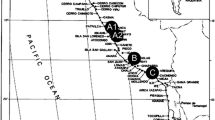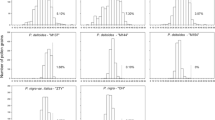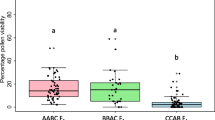Abstract
The ability of 13 Nemesia species (six annual and seven perennial) to sexually hybridize was investigated. Six of the perennial Nemesia species investigated were inter-fertile with one another. Two of the annual species, N. macroceras and N. strumosa, were inter-fertile. Thirty three crosses were successful and resulted in viable seeds. The analysis of meiotic chromosome behaviour in interspecific hybrids indicated that Nemesia chromosomes in different parental species were homeologous. No evidence of chromosome inversions or chromosome translocations was observed during meiosis in interspecific hybrids between the six perennial Nemesia species. In the hybrids produced between N. macroceras and N. strumosa, a quadrivalent was observed during meiotic metaphase I, indicating that these two species differ by a reciprocal translocation. A successful hybridization was made between N. anisocarpa (annual) and N. foetans (perennial), producing two triploid hybrids. In the unsuccessful crosses, pollen tubes were observed entering ovaries and ovules, suggesting that post-fertilization barriers were preventing sexual hybridization. Many of these crosses produced nonviable, shrunken, empty seeds, suggesting that endosperm breakdown and embryo abortion prevent interspecific hybridization in unsuccessful crosses. The manipulation of ploidy levels in N. fruticans and N. strumosa and tissue culture of N. strumosa × N. fruticans ovules failed to overcome post-fertilization barriers between these species.
Similar content being viewed by others
Abbreviations
- DAP:
-
days after pollination
- HAP:
-
hours after pollination
- SC:
-
self-compatible
References
Agnihotri A (1993) Hybrid embryo rescue. In: Lindsey, K (ed), Plant Tissue Culture manual; Fundamentals and applications. pp. 1–8. Kluwer Academic Publishers, Dordrecht
Andrews S (1997) Certain Nemesia in cultivation. The Hardy Plant 19: 51–57
Arnold ML (1997) Natural Hybridization and Evolution. Oxford University Press, New York
Bailey LH (1914) The Standard Cyclopedia of Horticulture. The Macmillan Company, New York
Buitendijk JH, Pinsonneaux N, Van Donk AC, Ramanna MS, Van Lammeren AAM (1995) Embryo rescue by half-ovule culture for the production of interspecific hybrids in Alstroemeria. Sci Hortic 64: 65–75
Bushell C, Spielman M, Scott RJ (2003) The basis of natural and artificial postzygotic hybridization barriers in Arabidopsis species. Plant Cell 15: 1430–1442
Datson PM (1997) Interspecific hybridization in the genus Nemesia Vent. MSc Thesis. The University of Auckland, New Zealand
Docherty Z (1982) Self-incompatibility in Nemesia. Heredity 48: 137–138
Geier T (1991) Chromosome variability in callus produced plants. In: Harding J Singh F and Mol JNM (eds), Genetics and breeding of ornamental species pp. 79–108. Kluwer, London
Goldblatt P (1978) An analysis of the flora of southern Africa: its characteristics, relationships and origins. Ann Mo Bot Gard 65: 369–436
Goodman RM, Hauptli H, Crossway A, Knauf VC (1987) Gene transfer in crop improvement. Science 236: 48–54
Henny RJ, Ascher PD (1976) The inheritance of pseudo-self-compatibility (PSC) in Nemesia strumosa (Benth.). Theor Appl Genet 48: 185–195
Herr JM Jr (1971) A new clearing-squash technique for the study of ovule development in angiosperms. Am J Bot 58: 785–790
Herrick JF, Murray BG, Hammett KRW (1993) Barriers preventing hybridization of Lathyrus odoratus with L. chloranthus and L. chrysanthus. NZJ Crop Hort Sci 21: 115–121.
Heslop-Harrison J, Heslop-Harrison Y (1970) Evaluation of pollen viability by enzymatically induced fluorescence: Intracellular hydrolysis of fluorescein diacetate. Stain Technol 45: 115–120
Jackson RC (1973) Chromosomal evolution in Haplopappus gracilis: a centric transposition race. Evolution 27: 243–256
Jackson RC (1982) Polyploidy and diploidy: new perspectives on chromosome pairing and its evolutionary implications. Am J Bot 69: 1512–1523
Jauhar PP, Joppa LR (1996) Chromosome pairing as a tool in genome analysis: Merits and limitations. In: Jauhar, PP (ed), Methods of Genome Analysis in Plants, pp. 9–38. CRC Press, New York
Johnston SA, den Nijs TPM, Peloquin SJ Jr, Hanneman RE (1980) The significance of genic balance to endosperm development in interspecific crosses. Theor Appl Genet 57: 5–9
Koella JC (1993) Ecological correlates of chiasma frequency and recombination index of plants. Biol J Linn Soc 48: 227–238
Lester RN, Kang JH (1998) Embryo and endosperm function and failure in Solanum species and hybrids. Ann Bot 82: 445–453
Maheshwari P (1950) An Introduction to the embryology of angiosperms. McGraw-Hill Book Co., New York
Maheshwari P, Rangaswamy NS (1965) Embryology in relation to physiology and genetics. In: Preston, RD (ed). Advances in Botanical Research Vol. 2, pp. 219–312. Academic Press, London
Martin FW (1959) Staining and observing pollen tubes in the style by means of fluorescence. Stain Technol 34: 125–128
Masuelli RW (2001) Mitotic-cycle time and the development of embryo and endosperm in compatible and incompatible crosses in tuber-bearing Solanum species. Genome 44: 426–431
Murashige T, Skoog F (1962) A revised medium for rapid growth and bio-assays with tobacco tissue cultures. Physiol Plant 15: 473–497
Murray BG (1976) The cytology of the genus Briza L. (Gramineae) II. Chiasma frequency, polyploidy and interchange heterozygosity. Chromosoma 57: 81–93
Murray BG (2003) Hybridization and plant breeding. In: Thomas B Murphy DJ Murray BG (eds), Encyclopedia of Applied Plant Sciences. pp. 119–125. Elsevier Academic Press, Oxford
Orr HA (1995), The population genetics of speciation: The evolution of hybrid incompatibilities. Genetics 139: 1805–1813
Palser BF, Rouse JL, Williams EG (1992) Techniques for clearing ovules for studies of megagametophyte and early postfertilization development in Rhododendron. Biotechnic and Histochemistry 67: 207–218
Pickersgill B (1993) Interspecific hybridization by sexual means. In: Hayward MD Bosemark NO Romagosa I (eds), Plant breeding; Principles and prospects. pp. 63–78. Chapman and Hall, London
Riley HP (1933) Self-sterility in Nemesia. Science 77: 326–327
Riley HP (1934) Self-sterility and self-fertility in species of the genus Nemesia. Am J Bot 22: 889–894
Stalker HT (1980). Utilization of wild species for crop improvement. Adv Agron 33: 111–147
Steiner KE (1996) Chromosome numbers and relationships in tribe Hemimerideae (Scrophulariaceae). Sys Bot 21: 63–76
Tilton VR, Russell SH (1984) In vitro culture of immature soybean embryos. J Plant Physiol 115: 191–200
von Wangenheim K-H, Peterson H-P (2004) Aberrant endosperm development in interploidy crosses reveals a timer of differentiation. Developmental Biology 270: 277–289
Williams EG (1987) Interspecific hybridization in pasture legumes. In: Plant Breeding Reviews, Vol 5, pp. 237–305
Zhang L, Murray BG, Pickering RA (2002) Variable patterns of chromosome synapsis at pachytene in Hordeum vulgare × H. bulbosum hybrids and their parents. Hereditas 137: 90–95
Author information
Authors and Affiliations
Corresponding author
Rights and permissions
About this article
Cite this article
Datson, P.M., Murray, B.G. & Hammett, K.R.W. Pollination systems, hybridization barriers and meiotic chromosome behaviour in Nemesia hybrids. Euphytica 151, 173–185 (2006). https://doi.org/10.1007/s10681-006-9138-z
Received:
Accepted:
Published:
Issue Date:
DOI: https://doi.org/10.1007/s10681-006-9138-z




